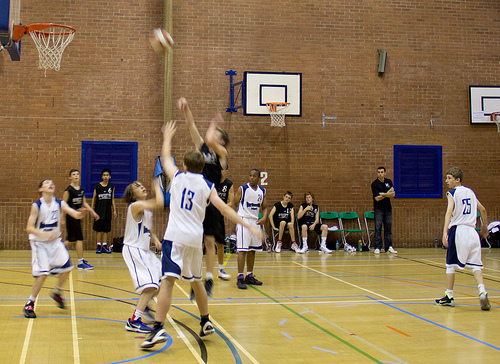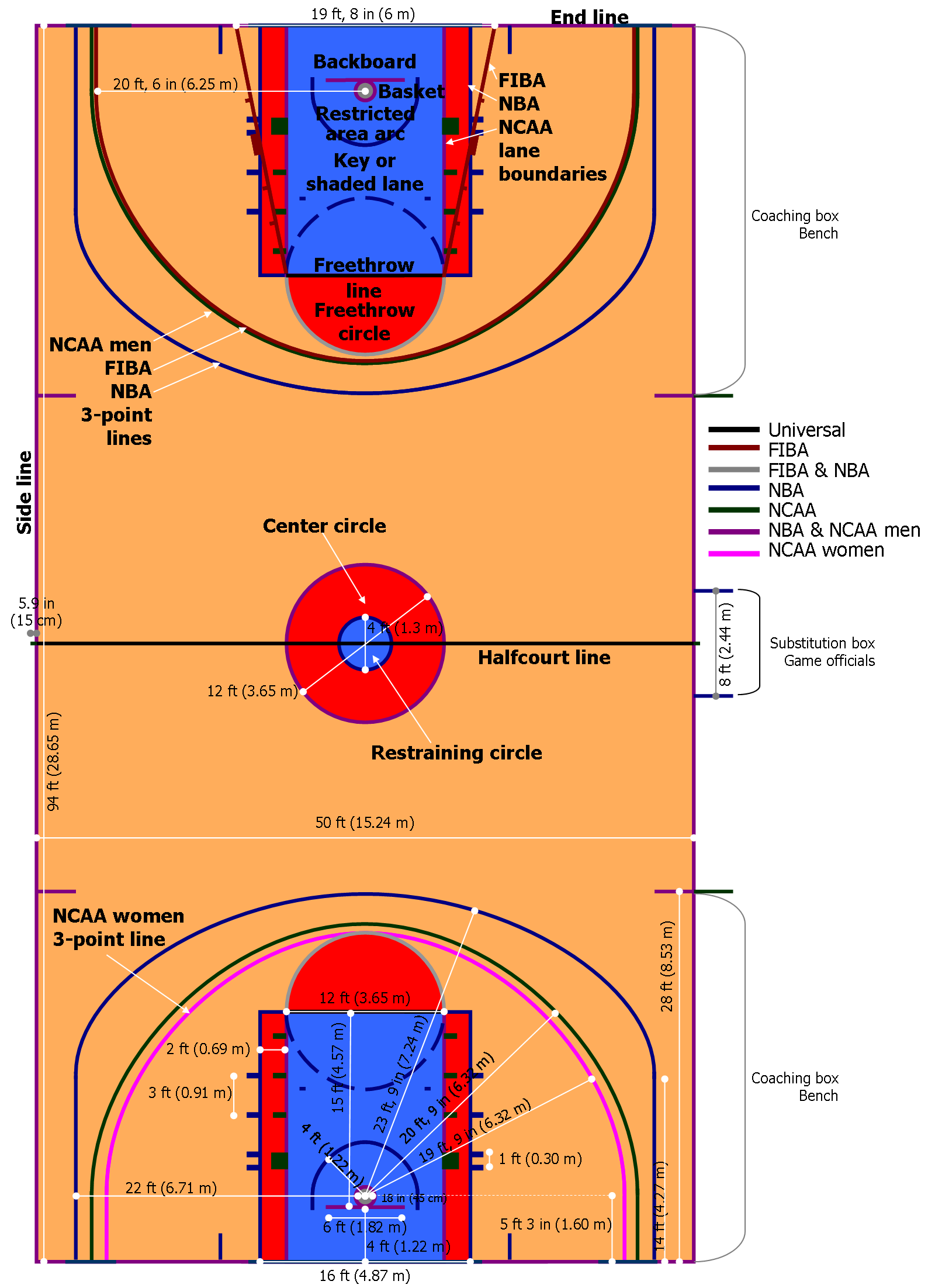A basketball court is always a rectangle with the same basic setup of a baseline, foul line, 3-point line, half court, and so on. But the exact basketball court dimensions depend on what level of basketball is being played - youth, junior high, high school, college or NBA. You can see a table of the dimensions as well as a basketball court diagram below.

Youth Basketball Game - Photo By: Nick Hubbard
Zone | NBA | NCAA | High School | Junior High |
|---|---|---|---|---|
Court Length | 94 | 94 | 84 | 74 |
Court Width | 50 | 50 | 50 | 42 |
3-point Line (from Basket) | 23.75, 22 in corners | 20.75 | 19.75 | 19.75 |
Free Throw Line (from backboard) | 15 | 15 | 15 | 15 |
*All measurements are made in feet. Tables are adapted from Wikipedia.
Basketball Court Diagram

Basketball Court Diagram - Photo By: Wikimedia
You can see from the basketball court diagram above that all basketball court dimensions have the same basic structure. There are many notable individual differences though, as you can see.
The rectangular shape of the court remains the same at all levels and the free throw line is always 15 feet from the backboard, not the baseline. The rim height remains at 10 feet, regardless of the level of competition.
The court gets longer for more advanced levels. It starts at 74 at the junior high level and then jumps to 84 for high school and then 94 for the NCAA and NBA. The court also gets wider for older age groups. It is only 42 feet wide for junior high, while high school on up is exactly 50 feet.
Along with the overall court size, the distance of the 3-point line from the basket changes. In junior high and high school, it is a distance of 19.75 feet. It adds a foot, at 20.75 feet, for the NCAA level.
The NBA and WNBA are unique in that they have multiple distances for their 3-point line. The NBA line is at 23.75 feet around the arc. The corners have a shorter 3-point line, as they are only 22 feet long.
The WNBA basketball court dimensions are the same as the NBA's everywhere except the 3-point line. The WNBA gets this from FIBA. The distance for their 3-point line is 22.15 feet around the arc and 21.65 feet in the corners.
The diagram above would put the half court line at 47 feet at all levels of basketball collegiate and above. The half court line would 42 feet for high school and 37 feet for junior high.
NBA Court Dimensions
94 feet long x 50 feet wide
The NBA court is the largest there is, although it is matched by the collegiate court. It is distinctive from college because of the longer 3-point line, which is 3 feet longer around the arc and 1.25 longer in the corners.
Other than this, it is virtually indistinguishable from the collegiate court. It is also important to note that the WNBA has the same exact dimensions, except for a slightly shorter 3-point line, as mentioned above.
NCAA Court Dimensions
94 feet long x 50 feet wide
Athletes have to adjust to a larger court when they move from high school to college, as the NCAA court is 10 feet longer than high school. This makes it the same size as the NBA and WNBA courts.
It also provides a step up in distance for the 3-point line as it is a foot longer, at 20.75 feet. This is significantly shorter than the NBA and even the WNBA. Other than this, it has the same basic setup as those other levels.
The extra length can be an adjustment for athletes. Potentially adding 10 feet on every sprint up and down the court can have a serious impact on conditioning.
While college freshman should have plenty of time to adapt to this change, there is still an adaptation period. Other than conditioning, it can also impact the athlete's rhythm and timing, especially in transition situations when plays could take longer to develop, on both offense and defense.
High School Court Dimensions
84 feet long x 50 feet wide
As basketball players move from junior high to high school, the court gets significantly larger in both directions. The high school court is 10 feet longer and 8 feet wider than the one used for junior high.
This is about the only difference from junior high, as all the other landmarks remain the same. The college court adds 10 feet in length but is otherwise about the same, other than a 1 feet distance increase in the 3-point line.
Moving from junior high to high school may cause the greatest adjustment for any athlete because the court gets both longer and wider. This will cause the game to have a much different feel.
With athletes getting bigger at the high school, the extra room is welcome. This helps open up the game and create spacing that just would be too cramped in junior high. While the added size is beneficial, it will take some time for freshman to adjust, although that should only take a few practices.
Junior High Court Dimensions
74 feet long x 42 feet wide
You might not even realize you were looking at a small court when looking at a junior high basketball court. It has the same basic layout and look as is seen at all other levels. It's as if it is a professional court, just shrunk a little bit.
The junior high basketball court is unique in that it is the only level in the United States to have a width less than the standard 50 feet. In junior high, the width is on 42 feet. It is also by far the shortest court at 74 feet, which is 10 feet shorter than high school and 20 feet shorter than college and professional.
Recap
Although an empty basketball court can seem large and spacious, basketball games are often decided by inches. Knowing the layout and spacing of the court can give you the slightest advantage on an opponent that is needed to help your game.

